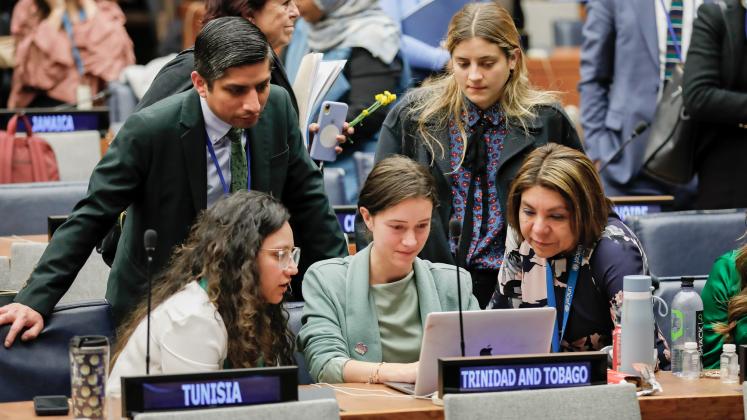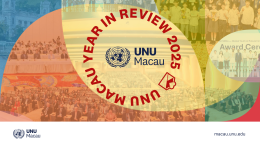In September, United Nations Member States will gather in New York for a once-in-a-generation meeting. Under the theme “multilateral solutions for a better tomorrow," the Summit of the Future will bring together world leaders to reaffirm the need for international cooperation and reach a consensus on how to safeguard our shared future.
Alarmingly, with just six years left to achieve the Sustainable Development Goals (SDGs), only 17% of the SDG targets are on track to being met by the end of the decade. Amid escalating conflict, a boiling climate and an uncertain economic outlook, the Summit of the Future is punctual in getting us to realign our commitment to the goals and beyond.
By bringing attention back to the foundational elements of multilateralism — consultation, collective decision-making, trust and solidarity — the summit will culminate in a Pact for the Future that will reframe global governance to better address current and emerging issues ranging from digital cooperation and development financing to peace and security, employment, gender equality and youth engagement.
The pact will also have two key annexes. The first is the Declaration on Future Generations, which, through a series of objectives and actions, commits to meeting the demands of the present while protecting the interests and requirements for a sustainable future that leaves no one behind.
The second annex is the Global Digital Compact. It will establish an inclusive global framework intended to overcome digital and data divides as we work to achieve the SDGs and cultivate a secure, human-centred and equitable digital future rooted in human rights.
The importance of the compact cannot be overstated. Technological change is moving at breakneck speed and digital innovation is impacting every aspect of our lives. We must proactively close the digital divide across regions, genders and social groups, and find new forms of international governance to foresee and combat the potentially negative consequences of technological advances.
Our digital innovation ambitions must revolve around equality, peace and security, and human rights. The Global Digital Compact will keep us focused on this goal.
If we expect to use AI and other technologies to overcome persistent sustainable development challenges, we need digital innovations to emerge from the places facing those challenges.
The open process to produce the compact’s current draft has been intensive. More than 6,000 entities — including from the private sector, civil society, academia and governments — from all over the world gave their input through online consultations. The result is comprehensive and will provide direction and foresight as we embark on our digital future.
Each of the compact’s guiding principles is essential to realizing its commitments and taking action. And much like the SDGs, its principles overlap and reinforce each other.
Some of these align particularly well with our efforts to harness the power of technologies like artificial intelligence to achieve sustainable development.
First, digital technologies must be environmentally sustainable. AI has enormous potential to unlock new efficiencies and environmental benefits in areas from agriculture and logistics to energy and climate modeling.
However, to ensure a secure technological future, we must pay attention to the ways digital solutions could undermine environmental gains. For example, the demand for extensive arrays of computer servers leads to the consumption of vast volumes of water, putting new stress on our already water-scarce world, its agricultural systems and people’s basic water needs.
Just as AI is helping us discover and more efficiently use the raw materials needed to build and power digital technologies, we must balance this with the environmental impact of our consumption and production patterns. Every material link in the chain of digital technology needs to be evaluated for its sustainability and environmental gains and losses.
A second key principle is that digital technologies such as AI should be innovation-friendly. This extends beyond national and private sector policies to the global level. Economic and geopolitical competition will always play a part in the technology sector, but our digital future will be accompanied by worsening inequality if we do not deliberately foster partnerships between the Global North and Global South.
If we expect to use AI and other technologies to overcome persistent sustainable development challenges, we need digital innovations to emerge from the places facing those challenges, including through partnerships.
This also connects to the impact of new tech on issues such as ‘brain drain’ — when a country’s brightest workers emigrate to find more lucrative and successful jobs abroad. This is already a concern in my home country of South Africa, where the health-care sector is experiencing a shortage of medical professionals.
If jobs focused on developing innovative technologies are concentrated in a few countries — for example, a lot of AI research and development is currently in the United States — then it is increasingly difficult for other countries to build and retain highly skilled workforces. This trend risks shifting local “brains” to working on solutions that do not respond to their countries’ economic and development challenges.
If we remain steadfast in our objective to close digital and data divides through international cooperation, then we can stimulate a technology culture that seeks answers to global challenges.
This connects to the third principle: Digital technologies must be oriented toward sustainable development. We must continually ask ourselves how advances will solve problems beyond their immediate context or country and how digital innovation can be attuned to the needs of different regions, societies and economies.
If we remain steadfast in our objective to close digital and data divides through international cooperation, then we can stimulate a technology culture that seeks answers to global challenges. This is essential to fast-track progress across every SDG.
The Summit of the Future will be a meeting like no other because we are living in a time like no other. We are on the edge of a technological revolution that has the power to make or break our path to sustainable development. However, to preempt and overcome the next generation’s development challenges, we need a new vision.
In the words of UN Secretary-General Antonio Guterres, “We can't build a future for our grandchildren with a system built for our grandparents.” The Pact for the Future, the Declaration on Future Generations and the Global Digital Compact will become the foundation for a renewed system and bold action.
This article was first published by The Japan Times. Read the original article on The Japan Times website.
Suggested citation: Marwala Tshilidzi. "The UN Is Charting a New Course for Our Technology Future," United Nations University, UNU Centre, 2024-08-28, https://unu.edu/article/un-charting-new-course-our-technology-future.



